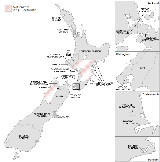
New Zealand general election, 1855
Encyclopedia
The 1855 New Zealand general election was a nationwide vote to determine the shape of the New Zealand Parliament's 2nd term
. It was the second national election ever held in New Zealand
, and the first one which elected a Parliament that had full authority to govern the colony.
had been held after the passage of the New Zealand Constitution Act 1852
by the Parliament of the United Kingdom
. The 1st Parliament
did not have the ability to appoint the executive branch (Cabinet
) of the New Zealand government, however, and a major dispute arose between Parliament and the Governor
. In the 2nd Parliament, Parliament gained the powers it sought — for this reason, some see the 1855 elections, not the 1853 elections, as the beginning of New Zealand democracy.
At the time of the 1855 elections, there were no political parties in New Zealand. As such, all candidates were independents
. Governments were formed based on loose coalitions, with prospective Prime Ministers
needing to seek support from enough individual MPs to command a majority. This means that nobody could truly be said to have "won" an election — a government usually rose or fell based on its ability to make deals with MPs, not on election results.
2nd New Zealand Parliament
The 2nd New Zealand Parliament was a term of the Parliament of New Zealand. It opened on 15 April 1856, following New Zealand's 1855 election. It was dissolved on 5 November 1860 in preparation for 1860–61 election...
. It was the second national election ever held in New Zealand
New Zealand
New Zealand is an island country in the south-western Pacific Ocean comprising two main landmasses and numerous smaller islands. The country is situated some east of Australia across the Tasman Sea, and roughly south of the Pacific island nations of New Caledonia, Fiji, and Tonga...
, and the first one which elected a Parliament that had full authority to govern the colony.
Background
The first New Zealand electionsNew Zealand general election, 1853
The 1853 New Zealand general election was a nationwide vote to determine the shape of the New Zealand Parliament's 1st term. It was the first national election ever held in New Zealand, although Parliament did not yet have full authority to govern the colony, which was part of the British Empire at...
had been held after the passage of the New Zealand Constitution Act 1852
New Zealand Constitution Act 1852
The New Zealand Constitution Act 1852 was an Act of the Parliament of the United Kingdom that granted self-government to the colony of New Zealand...
by the Parliament of the United Kingdom
Parliament of the United Kingdom
The Parliament of the United Kingdom of Great Britain and Northern Ireland is the supreme legislative body in the United Kingdom, British Crown dependencies and British overseas territories, located in London...
. The 1st Parliament
1st New Zealand Parliament
The 1st New Zealand Parliament was a term of the Parliament of New Zealand. It opened on 24 May 1854, following New Zealand's first general election . It was dissolved on 15 September 1855 in preparation for that year's election...
did not have the ability to appoint the executive branch (Cabinet
New Zealand Cabinet
The Cabinet of New Zealand functions as the policy and decision-making body of the executive branch within the New Zealand government system...
) of the New Zealand government, however, and a major dispute arose between Parliament and the Governor
Governor-General of New Zealand
The Governor-General of New Zealand is the representative of the monarch of New Zealand . The Governor-General acts as the Queen's vice-regal representative in New Zealand and is often viewed as the de facto head of state....
. In the 2nd Parliament, Parliament gained the powers it sought — for this reason, some see the 1855 elections, not the 1853 elections, as the beginning of New Zealand democracy.
At the time of the 1855 elections, there were no political parties in New Zealand. As such, all candidates were independents
Independent (politician)
In politics, an independent or non-party politician is an individual not affiliated to any political party. Independents may hold a centrist viewpoint between those of major political parties, a viewpoint more extreme than any major party, or they may have a viewpoint based on issues that they do...
. Governments were formed based on loose coalitions, with prospective Prime Ministers
Prime Minister of New Zealand
The Prime Minister of New Zealand is New Zealand's head of government consequent on being the leader of the party or coalition with majority support in the Parliament of New Zealand...
needing to seek support from enough individual MPs to command a majority. This means that nobody could truly be said to have "won" an election — a government usually rose or fell based on its ability to make deals with MPs, not on election results.

